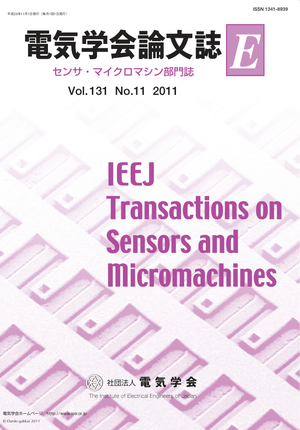電解メッキによる金属微細針の作製と電解エッチングによる先鋭化
電解メッキによる金属微細針の作製と電解エッチングによる先鋭化
カテゴリ: 論文誌(論文単位)
グループ名: 【E】センサ・マイクロマシン部門
発行日: 2011/11/01
タイトル(英語): Fabrication of Metallic Microneedle by Electroplating and Sharpening of it by Electrochemical Etching
著者名: 黄 志濠(関西大学),田中 隆寛(関西大学),高沖 穣(関西大学),泉 隼人(名古屋工業大学),高橋 智一(関西大学),鈴木 昌人(関西大学),青柳 誠司(関西大学)
著者名(英語): Chih-hao Huang (Kansai University), Takahiro Tanaka (Kansai University), Yutaka Takaoki (Kansai University), Hayato Izumi (Nagoya Institute of Technology), Tomokazu Takahashi (Kansai University), Masato Suzuki (Kansai University), Seiji Aoyagi (Kansai University)
キーワード: マイクロニードル,MEMS,電解メッキ,電解エッチング,先鋭化 microneedle,MEMS,electroplating,electrochemical etching,sharpening
要約(英語): Aiming at the use in low-invasive medical treatments, this paper reports a fabrication of metallic microneedle, which has a three-dimensionally sharp tip. Compared to a silicon or polymer needle which we previously proposed, a metallic needle has toughness to evade breakage. Even if it is broken, it does not become small pieces thanks to its ductility, which increases the safety for a human body. A nickel needle was fabricated using electroplating, followed by sharpening it by electrochemical etching. A smooth tip surface is obtained due to electrochemical etching reactions. Sharpness and smoothness of the tip are effective for easy insertion in the viewpoint of large stress concentration and small friction, respectively. An experiment of inserting the fabricated needle into an artificial skin of silicone rubber was carried out. The resistance force during insertion was much reduced compared to that of commercial stainless needle (23 G: shank diameter 650 μm). Although a fabricated metallic needle was inserted and pulled-out for several times, it was not broken in any trial. By changing the angle between object surface and needle axis, the insertion experiments were carried out. Fabricated nickel needle was not broken for any angle, while silicon needle was broken in case the angle is small, i.e., the needle is much inclined from normal direction of the surface, which ensures the safety of metallic microneedle to human body in the viewpoint of breakage.
本誌: 電気学会論文誌E(センサ・マイクロマシン部門誌) Vol.131 No.11 (2011)
本誌掲載ページ: 373-380 p
原稿種別: 論文/日本語
電子版へのリンク: https://www.jstage.jst.go.jp/article/ieejsmas/131/11/131_11_373/_article/-char/ja/
受取状況を読み込めませんでした


